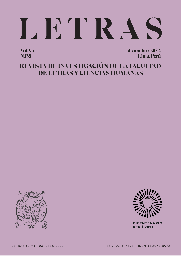Science and “narrativity”. Towards a classification of the uses of narrative in the exact and natural sciences
DOI:
https://doi.org/10.30920/letras.93.138.11Keywords:
Scientific discourse, Narrative textuality, Agency, Degree of narrativity, Narrative effectAbstract
This article addresses some manifestations of narrative in science with the broader intention of contributing to the understanding of its use in factual domains. First, taking as a starting point some previous approaches to the problem of “narrativity”, a theoretical-analytical model is proposed that specifies ten conditions of narrativity. Then, the aim is to determine the areas of scientific discursive production that are more permeable to narrative textuality based on a measurement of the degrees of narrativity of different textual genres. Thus, the differences between texts that report on established knowledge and those that provide new knowledge are explored; a distinction is made between the institutional communication of science and its dissemination; the persuasive and illustrative uses of narrative are addressed; and the field of historical sciences is delimited as a privileged realm of narrative explanation. Finally, the article proposes some conclusions aimed at showing the usefulness of applying the approach of the degrees of narrativity to think about the reception of the discourse of science and what has been called the “narrative effect”.
References
Abbott, H. P. (2002). The Cambridge Introduction to Narrative. Cambridge University Press.
Adúriz-Bravo, A. y Revel Chion, A. (2016). El pensamiento narrativo en la enseñanza de las ciencias. Goiânia, 41(3), 691-704. https://doi.org/10.5216/ia.v41i3.41940
Avraamidou, L. y Osborne, J. F. (2009). The role of narrative in science education. International Journal of Science Education, 31(4), 1-25. https://doi.org/10.1080/09500690802380695
Bartumeu, R. O., Cepero, O., Castillo, J. C. y Perez, S. (2005). Evaluación de la efectividad de un desinfectante derivado del grupo de los amonios cuaternarios para el enfrentamiento a los desastres biológicos. Revista Electrónica de Veterinaria REDVET, 6(3), s. n. p.
Benveniste, E. (1971). Problemas de lingüística general, tomo I. Siglo XXI.
Brandt, Ch. (2009). Wissenschaftserzählungen. Narrative Strukturen in naturwissenschaftlichen Diskurs. En Klein, Ch. y Martínez, M. (Eds.), Wirklichkeitserzählungen. Felder, Formen und Funktionen nicht-literarischen Erzählens (pp. 81-109). Meztler.
Brémond, C. (1970 [1966]). La lógica de los posibles narrativos. En AAVV., Análisis estructural del relato (pp. 87-109). Trad. de B. Dorriots. Tiempo Contemporáneo.
Bruner, J. (1986). Actual Minds. Possible Worlds. Harvard University Press.
Dahlstrom, M. F. (2014). Using narratives and storytelling to communicate science with nonexpert audiences. Proceedings of the National Academy of Science, 111(4), 13614-13620. https://doi.org/10.1073/pnas.1320645111
Danto, A. C. (2014). Narración y conocimiento. Trad. de L. F. Lassaque. Prometeo.
Filinich, M. I. (1998). Enunciación. Eudeba.
Fludernik, M. (2009). Narrative and Narrating. En M. Fludernik, An Introduction to Narratology (pp. 1-7). Nueva York: Routledge.
Fludernik, M. y Ryan, M.-L. (2019). Narrative Factuality. A Handbook. De Gruyter.
García Negroni, M. M. (2008). Subjetividad y discurso científico-académico. Acerca de algunas manifestaciones de la subjetividad en el artículo de investigación en español. Revista Signos, 41(66), 5-31. http://dx.doi.org/10.4067/S0718-09342008000100001
Genette, G. (1970 [1966]). Fronteras del relato. En AAVV., Análisis estructural del relato (pp. 193-208). Trad. de B. Dorriots. Tiempo Contemporáneo.
Glaser, M., Garsoffky, B. y Schwan, S. (2009). Narrative-based learning: Possible benefits and problems. European Journal of Communication Research, 34(4), 429-447. https://doi.org/10.1515/COMM.2009.026
Harré, R. (1981). Great Scientific Experiments. Phaidon Press.
Harré, R. (2005 [1990]). Some Narrative Conventions of Scientific Discourse. En Nash, Ch. (Ed.), Narrative in Culture. The Uses of Storytelling in the Sciences, Philosophy and Literature (pp. 83-102). Routledge.
Hempel, C. G. (2003 [1966]). Filosofía de la ciencia natural. Versión de A. Deaño. Alianza.
Holmes, F. L. (1991). Argument and Narrative in Scientific Writing. En Dear, P. (Ed.), The Literary Structure of Scientific Argument: Historical Studies (pp. 164-181). University of Pennsylvania Press.
Lyotard, J.-F. (1984 [1979]). The Postmodern Condition. A Report on Knowledge. University of Minnesota Press.
Maingueneau, D. (2009). Análisis de textos de comunicación. Buenos Aires: Nueva Visión.
Millar, R. y Osborne, J. (Eds.). (1998). Beyond 2000: Science education for the future. King’s College London.
National Geographic. (2022, 28 de marzo). La extinción de los dinosaurios. https://www.nationalgeographic.es/historia/la-extincion-de-los-dinosaurios
Norris, S. P., Guilbert, S., Smith, M., Hakimelahi, S. y Phillips, L. (2005). A theoretical framework for narrative explanation in science. Science Education, 89(4), 535- 563. https://doi.org/10.1002/sce.20063
Padian, K. (2018). Narrative and ‘Anti-Narrative’ in Science: How Scientists Tell Stories, and Don’t. Integrative and Comparative Biology, 58(6), 1224-1234. https://doi.org/10.1093/icb/icy038
Paladino, S., Nazrala, J., Vila, H., Genovart, J., Sánchez, M. L. y Maza, M. (2008). Oxidación de los vinos tintos: influencia del pH. Rev. FCA UNCuyo, 40(2), 105-112. https://bdigital.uncu.edu.ar/2733
Plotnisky, A. (2005). Science and Narrative. En Herman, D. David et ál. (Eds.), Routledge Encyclopedia of Narrative Theory (pp. 514-518). Routledge.
Prince, G. (1987). A Dictionary of Narratology. University of Nebraska Press.
Ruppert, E. y Barnes, R. D. (1996). Zoología de los inverterbrados. [6.ª Ed. en español]. Coord. de la trad. F. P. Martínez. Interamericana.
Ryan, M.-L. (2007). Toward a Definition of Narrative. En Hermann, D. (Ed.), The Cambridge Companion to Narrative (pp. 22-38). Cambridge University Press.
Smolin, L. (1997). The life of the cosmos. Weidenfeld & Nicholson.
ZetaPositivo. (2013, 7 de marzo). Lysoform bacterias acuáticas [Video]. https://www.youtube.com/watch?v=cvlL-OLsddk
Downloads
Published
Issue
Section
License
Copyright (c) 2022 Martín Ignacio Koval

This work is licensed under a Creative Commons Attribution 4.0 International License.






